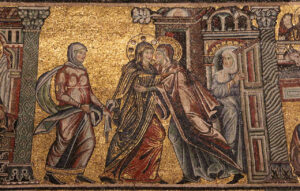Advent calendars are a fun and increasingly popular way to countdown the days until Christmas. It seems every brand has its own version these days, from sweet treats like chocolate to luxury beauty and fashion items.
However, not all of them are successful with consumers. In fact, the season’s biggest complaints have been aimed at luxury fashion house Dior, which released a limited-edition version of its 2022 advent calendar for the astonishing price of $3,500.
Due to the stunning price tag, fans of the brand had high expectations. Yet multiple items in the “Trunk of Dreams” have humorously underwhelmed.
Where Did Advent Calendars Come From?
Commercial advent calendars have been around since the early 1900s. German publisher Gerhard Lang is considered their inventor, producing the first printed advent calendar with illustrator Ernst Kepler around that time.
He continued to innovate the concept, including the addition of doors that opened to reveal small prizes, until World War II brought a halt to paper manufacturing.
@jackieaina I’m ngl I’m kinda into this advent calendar thing this year 😭 #dioradventcalendar #adventcalendarreview
♬ B.O.T.A. (Baddest Of Them All) – Eliza Rose & Interplanetary Criminal
After the war, servicemen and women brought the calendars back to Europe and the United States. They became a massive hit after President Dwight Eisenhower was photographed opening one with his grandchildren in 1953.
It was chocolate company Cadbury that first commercially produced the calendars with chocolate treats behind each door. Since then, the prizes have expanded from sweets to skincare to doll accessories, but their core intent has remained the same: an exciting way to prolong the Christmas season with family.
How Dior Missed the Mark
Social media beauty influencer, Jackie Aina, purchased the limited edition La Collection Privée Christian Dior advent calendar to open on video and share the experience with her subscribers.
The calendar, described on Dior’s website as “a stunning piece, made up of a wooden structure lined with cotton canvas and featuring sketches by Pietro Ruffo” is crafted to look like the Dior store in Paris.
@jackieaina Replying to @justicebiond day 12✨Dior✨advent unboxing #dioradventcalendar #adventcalendarreview
♬ B.O.T.A. (Baddest Of Them All) – Eliza Rose & Interplanetary Criminal
For the amount of care put into the packaging along with the lofty price tag, Aina and her 1.8 million viewers’ expectations were sky high. A TikTok video on Aina’s account calculated that each of the 24 items should have about $145 dollars worth of value based on the calendar’s purchase price.
From day one, the items did not meet those expectations. Aina noted the four mini-fragrances that each took up one day in the calendar are actually sample size gifts that shoppers receive for free with purchases on Dior’s website.
Day four looked slightly better, with a full-size Christmas themed candle emerging from the drawer. However, day six created an influencer outrage after its drawer was discovered to contain only the candle’s lid.
@jackieaina Replying to @itsthatwife Day 17 Dior advent calendar #adventcalendars #dioradventcalendar
♬ B.O.T.A. (Baddest Of Them All) – Eliza Rose & Interplanetary Criminal
An exasperated Aina questioned, “Uh, girl, the lid to the candle, I think?” as she revealed the drawer’s contents. “Okay…” she reacted, decidedly unimpressed.
Her viewers were equally unenthused by the candle lid.
“They lowkey scammed with day 6,” one subscriber commented.
“WAIT. Excuse me, they dedicated a whole advent calendar day for a lid for your candle,” another said.
“The lid? Dior is disrespectful for that,” chimed another.
In a follow up video, Aina opened the remaining drawers, hoping for a turnaround.
Yet drawer 13 was discovered to be equally offensive, containing a nearly identical looking item to the candle lid which was determined to be a candle stand.
“It is what it is, but it isn’t that great,” Aina declared.
Viewers went as far as to suggest Aina return the calendar for a refund, with one stating it seemed almost all of the items were “testers that they need to get rid of”.
“I’m crying this is the worst calendar,” another viewer wrote.
One fan referenced the similarly ill-received advent calendar from Chanel the year prior. “Chanel advent 2.0,” they commented.
Chanel was compelled to respond to criticism of its calendar after another influencer, Elise Harmon, posted a series of disappointing unboxing TikToks that went viral.
@jackieaina Replying to @allyyyyloveeeee is the Dior Advent calendar worth the splurge?
♬ B.O.T.A. (Baddest Of Them All) – Eliza Rose & Interplanetary Criminal
The oversized white replica of Chanel’s classic perfume bottle contained drawers counting down the final days to Christmas; however, the days started on December 5th, presumably for “Chanel No. 5”, the company’s most famous scent.
Its drawers notoriously included items such as a sheet of stickers and an empty dust bag, prompting social media outcry.
Bruno Pavlovsky, president of fashion and president of Chanel, later addressed the outrage.
“This controversy is a bit of a shame because it was not what Chanel intended. Chanel thought it would please some of its customers by offering this type of product. Evidently, we see that you have to be careful and therefore, in future, we will certainly be much more cautious,” he said in an interview.
As of now, Dior has not addressed its calendar’s lackluster reviews.












